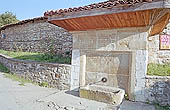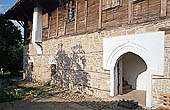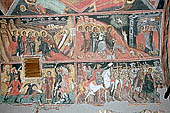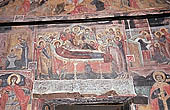Situated in the high plateau overlooking Veliko Turnovo the picturesque village of Arbanassi distinguishes itself for its architecture and churches with rich interior mural
paintings, proof of the economical prosperity and welfare of the village . Arbanassi has an unique
look with its narrow cobblestone alleyways between high stone walls and huge wooden gates protecting the houses with their characteristic austere aspect.
The local lace knitting women add charm to Arbanassi .
Arbanassi |

|
During the xvii and xviii century, when Arbanassi was an important commerce and crafts junction within the confines of the Ottoman
Empire, its wealthy villagers turned their houses into inaccessible fortresses to avoid the repeated incursions of thieves.
Surrounded with high walls, the Arbanassi house, in general, is in the middle of a large garden. You can enter the yard through two big oak gates that leads to the inner garden with flower beds. The house is built of
stone with small windows with iron grids, without balconies.

|
Arbanassi
|
The old Arbanassi fountains with eaves also are of interest. These are the
Kokon and Pazar fountains (Kokonska cheshma, Pazarska cheshma). The first one was built in 1786 by Mehmed Said Aga,
on the front the fountain has a stone inscription in old Arabic letters saying:
'Light will come in the eyes and soul of those who looks at it and drinks'
Opposite the Kokon fountain the Konstantsaliev house, now an attractive museum.
Built in xvii century it is one of the biggest and most decorated house in Arbanassi. It is a two-floor
house, the main entrance is protected with a solid studded door, the basement is built of
stone whilst the second floor is a wooden construction. Upstairs are the bedroom and
the kitchen, a drawing room (haet), a sitting-room (odaya) and a dining room. In the most remote part of the house,
there is the maternity room.
Arbanassi |

|
Of great interest are the seven Arbanassi churches.
Divided in two departments: a naos (the men's department) and
a narthex (a women's department) the Arbanassi
church is a stone construction with a
basilica plant, one-apse, semi-cylindrical vault under two-slope
roof.
At the beginning of the village the Holy Virgin Monastery houses the famous wonder-working icon of Holy Virgin.
The Nativity Church is the earliest in
Arbanassi. It consist of a naos, a narthex, a gallery running alongside on the north and on the west, while on the eastern side there is a chapel to "John the Baptist". The present day naos was originally a church on its own. Its painting was completed in 1597. The composition of: ‘The Judgement Day’ and ‘Nativity’ date back to those times. The painting of the woman's department was completed in 1638.
Paintings include the cycles of: The Jesse's
tree with Christ's predecessors, the presence of the antique philosophers and ancestors (Homer, Aristotle, Plato) was inspired by the humanistic tendencies of the time. The themes of Mother Mary's Ascension and of the Judgement Day testify to the great interest in the
cosmogonic issues, the genesis and history of mankind. The chapel to John the Baptist was painted in
1632 with themes of its life. The iconostasis is one of the earliest examples of woodwork in Bulgaria. Most of the paintings in the gallery were made in 1649. They are grouped in a calendar sequence of
"Menelogue" and represent stories from the New and Old Testaments and The Seven
Ecumenical Councils. The thematic cycles in the gallery are united in the scene of the ‘Vain Life in a Vain World’ or the ‘Wheel of Life’ with the zodiac signs. The paintings in the naos depict the Feasts, the Passions and Wonders of Christ. The paintings were completed in 1681.

|
Arbanassi
|
The church to St Archangels Michael and
Gabriel consist of a naos of a conical shape, a narthex, a chapel to St Paraskeva and a gallery. The naos was built and painted in 17th
century. The style of the mural paintings
represents the transition from the old
traditional iconographic schemes to a new style
that makes use of the perspective and new expressive techniques.
|
|
|



